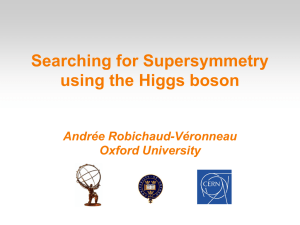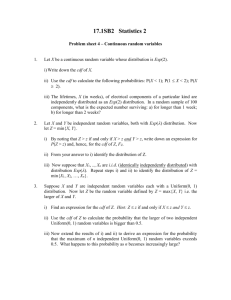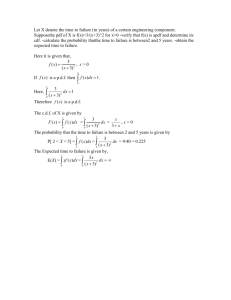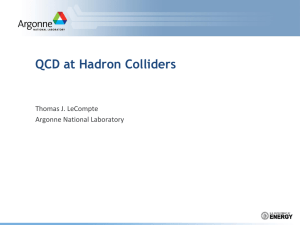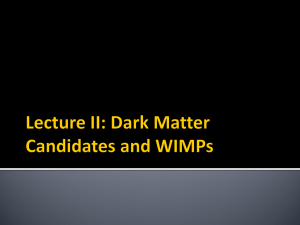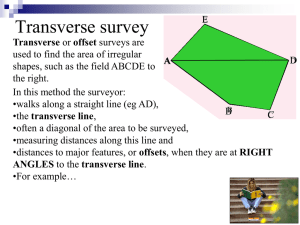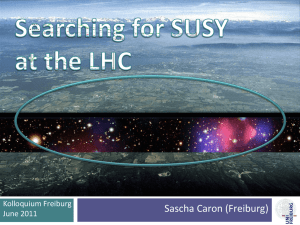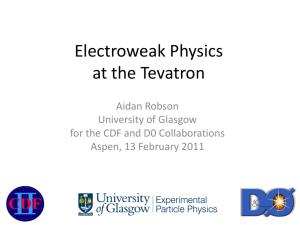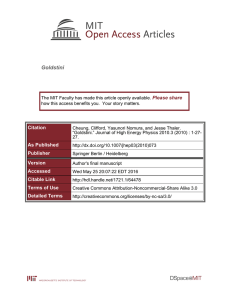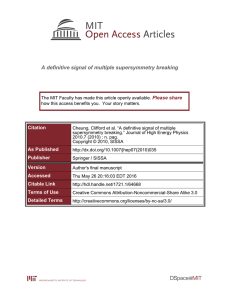(York) talk (September 2002) - Conference proceedings
advertisement
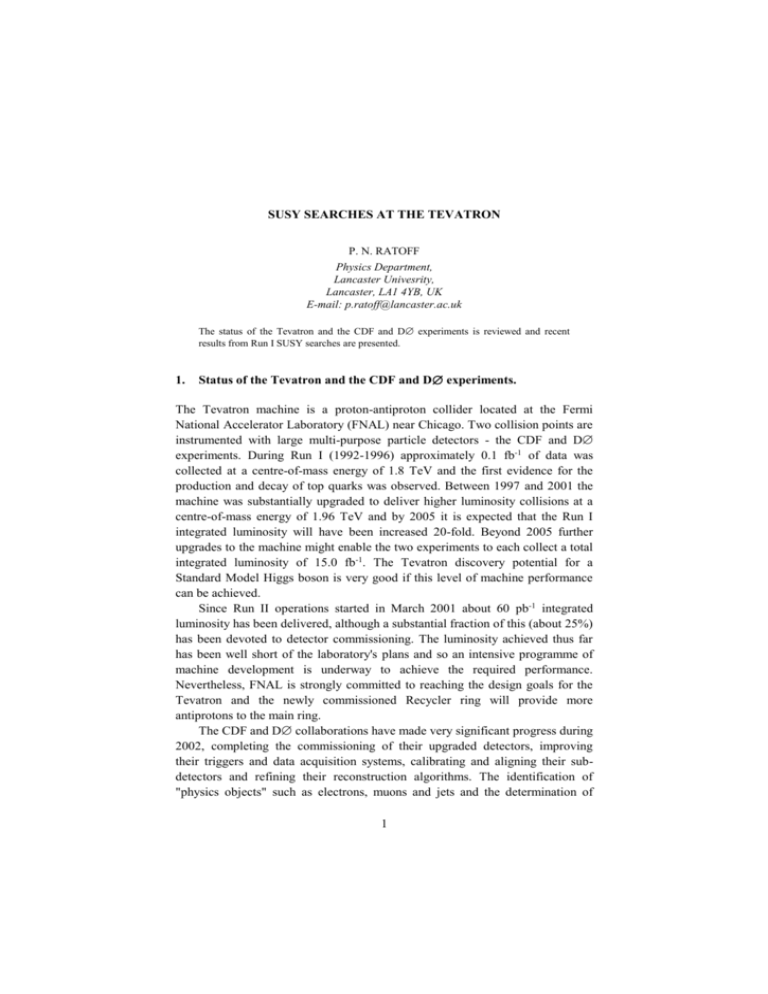
SUSY SEARCHES AT THE TEVATRON P. N. RATOFF Physics Department, Lancaster Univesrity, Lancaster, LA1 4YB, UK E-mail: p.ratoff@lancaster.ac.uk The status of the Tevatron and the CDF and D experiments is reviewed and recent results from Run I SUSY searches are presented. 1. Status of the Tevatron and the CDF and D experiments. The Tevatron machine is a proton-antiproton collider located at the Fermi National Accelerator Laboratory (FNAL) near Chicago. Two collision points are instrumented with large multi-purpose particle detectors - the CDF and D experiments. During Run I (1992-1996) approximately 0.1 fb-1 of data was collected at a centre-of-mass energy of 1.8 TeV and the first evidence for the production and decay of top quarks was observed. Between 1997 and 2001 the machine was substantially upgraded to deliver higher luminosity collisions at a centre-of-mass energy of 1.96 TeV and by 2005 it is expected that the Run I integrated luminosity will have been increased 20-fold. Beyond 2005 further upgrades to the machine might enable the two experiments to each collect a total integrated luminosity of 15.0 fb-1. The Tevatron discovery potential for a Standard Model Higgs boson is very good if this level of machine performance can be achieved. Since Run II operations started in March 2001 about 60 pb-1 integrated luminosity has been delivered, although a substantial fraction of this (about 25%) has been devoted to detector commissioning. The luminosity achieved thus far has been well short of the laboratory's plans and so an intensive programme of machine development is underway to achieve the required performance. Nevertheless, FNAL is strongly committed to reaching the design goals for the Tevatron and the newly commissioned Recycler ring will provide more antiprotons to the main ring. The CDF and D collaborations have made very significant progress during 2002, completing the commissioning of their upgraded detectors, improving their triggers and data acquisition systems, calibrating and aligning their subdetectors and refining their reconstruction algorithms. The identification of "physics objects" such as electrons, muons and jets and the determination of 1 2 electromagnetic and jet energy scales have proceeded with considerable success. The increase in the Tevatron collision energy and luminosity has necessitated various detector upgrades to accommodate higher event rates and backgrounds, principally in the front-end electronics, trigger and data acquisition systems. This has considerably expanded the physics capabilities of both experiments. 2. SUSY Models. SUSY is the best motivated scenario today for physics beyond the Standard Model. It doesn't contradict the precise Electroweak data, it predicts a light Higgs boson, it achieves unification of the gauge couplings at the GUT scale and is an essential element of string theories. It also provides an explanation for the Cold Dark Matter in the Universe. SUSY must be a broken symmetry otherwise the SUSY mass scale would be the same as the Standard Model mass scale. A variety of models have been proposed, differing mainly in the nature of the "messenger interactions". Most experimental results at the Tevatron have been obtained in the context of either Supergravity (SUGRA) models or Gauge Mediated SUSY Breaking (GMSB) models. The physics environment and expected SUSY phenomenology are quite different at electron-positron and hadron collider machines. In a hadron collider ~ q~ ), gluino pairs ( g~ g~ ) or squarkfinal states consisting of squark pairs ( q ~ g~ ) are expected to dominate. The squarks and gluinos are gluino pairs ( q ~q expected to be quite heavy, leading to multi-step cascade decay such as g ~ q+q+ + q ~ q + q + Z + ~ 0 0 2 1 , where ~ 0 2 and ~ 0 are the next-to- 1 lightest and lightest neutralinos. Consequently many high transverse momentum jets and leptons are produced with large missing transverse energy. In SUGRA models SUSY breaking is communicated to the physical sector by gravitational interactions. Grand Unification Scale (GUT) parameters combined with the Renormalisation Group Equation lead to a low energy scale phenomenology. In the highly constrained minimal SUGRA model there are just m , the common gaugino mass m , A , the ratio of the vacuum expectation 5 parameters - the common scalar mass the common trilinear coupling value 1 0 2 0 values of the two Higgs doublets tan and the sign of the Higgsino mass ~0 which is an parameter . The Lightest Supersymmetric Particle (LSP) is 1 excellent Cold Dark Matter candidate. R-parity is a discrete multiplicative quantum number that distinguishes Standard Model particles from their SUSY counterparts. It is equal to 3 (1) 3B L2S where B, L and S are the baryon number, lepton number and spin quantum numbers, and is therefore +1 for Standard Model particles and -1 for the corresponding SUSY particles. It is usually assumed to be a conserved quantity but R-parity violation (RPV) can be introduced via trilinear Yukawa coupling terms in the Superpotential. This implies that the LSP is unstable and cannot be a Cold Dark Matter candidate. Experimental signatures may be very different as a result and single sparticle production is possible. In minimal SUGRA just one RPV coupling is assumed to dominate. If the coupling is large enough resonant production will occur, otherwise pair production will dominate. In GMSB models the "messenger sector" couples to the source of SUSY breaking and the physical sector of the Minimal Supersymmetric Standard Model (MSSM) through gauge interactions. The identity of the Next-to-Lightest Supersymmetric Particle (NLSP) and its lifetime determine the phenomenology. ~0 then it should decay to a photon and a gravitino whilst if the If the NLSP is 1 NLSP is a charged slepton then it should decay to a charged lepton and a gravitino. 3. SUGRA searches 3.1. Single electron channel This search is sensitive to moderate values of m and complements dilepton 0 and jets plus missing transverse energy channels. Gluino pair production may ~ W + ~0 ), yielding an result in the production and decay of a chargino ( 1 1 electron and missing transverse energy. The backgrounds for this process are W + jets, QCD multjets and top-antitop quark pairs. From an integrated luminosity of 92.7 pb-1, D have observed 72 events with an expected background of 80 10 events. Fixing - m 0 A = 0, < 0 and tan = 3, the exclusion region in the m 0 1 2 plane is shown in Figure 1a [1]. 3.2. Stop search Mixing between the left- and right-handed stop particles is proportional to the top quark mass. The large expected mixing may therefore result in the lighter stop state being experimentally accessible. Stop-antistop pair production can result in a pair of charginos and two b quark jets and, assuming that the sneutrino is the LSP, the charginos will decay into a pair of charged leptons and a pair of 4 sneutrinos. The final state is 2 charged leptons plus jets plus missing transverse energy. The main backgrounds come from Drell-Yan pairs, heavy quark pair production, QCD fakes and diboson production. CDF have constrained the allowed region of the stop-sneutrino mass plane using their full Run I sample as shown in Figure 1b. Figure 1. (a) The exclusion regions in the m 1 2 m 0 plane for the D search in the single electron channel (left hand plot) and (b) the allowed region of the stop-sneutrino mass plane in the CDF stop search (right hand plot). 3.3. Decays of stop pairs Assuming RPV only in the 3rd generation, the stop can decay into a tau lepton and a b quark. CDF has performed a search for stop-antistop pairs in which one of the daughter tau leptons decays into a charged lepton and the other decays into hadrons. The final state is therefore a charged lepton, a tau lepton jet and two other jets. The background processes are W/Z + jets, multijets and dibosons. CDF have set a lower limit on the mass of the stop of 111 GeV/c² using their full Run I sample. 3.4. Pair production: dimuon channel D has searched for RPV decays of a neutralino LSP into a muon and a pair of quarks. The resulting final state involves 2 muons, 4 jets and no missing transverse energy. The main backgrounds are from Drell-Yan pairs, top-antitop pairs, Z + jets and Z . From 77.5 pb-1 they observed zero events with an expected background of 0.18 ± 0.04 events. For = 0, < 0 and tan 0 A = 2 they are able to set a lower limit on the gluino mass of about 250 GeV/c² (Figure 2a) [2]. With 2.0 fb-1 from Run II this will increase to about 800 GeV/ c². 5 3.5. Resonant production: dimuon channel With large RPV couplings resonant production and decay of the LSP is anticipated. D has searched for a 2 muons plus 2 jets final state where the main backgrounds come from top-antitop pairs, Z + 2 jets and WW + jets. They observed 5 events from 94 pb-1 with an expected background of 5.34 ± 0.07 events. For a range of values of the RPV couplings a substantial part of the m 1 2 m 0 m plane can be excluded for 1 < 260 GeV/c² and 2 m GeV/c² (Figure 2b). With 2.0 fb-1 the excluded region will increase to 900 GeV/c² and m 0 0 < 220 m 1 < 2 < 600 GeV/c². Figure 2. The exclusion regions in the m 1 2 m 0 plane for the D searches in (a) the pair produced dimuon channel (left hand plot) and (b) the resonantly produced dimuon channel (right hand plot). 4. GMSB searches 4.1. Light gravitino search The cross-section for gravitino pair production goes as the inverse 4 th power of the gravitino mass. So, if the gravitino is very light and all other SUSY particles are above the production threshold, SUSY can still be observed at the Tevatron by looking at final states including gravitinos and ordinary particles only. In this case the LSP is the gravitino which goes undetected giving rise to missing transverse energy. At the Tevatron the following processes are permitted (G is 6 the gravitino): q q GGg, qg GGq, gg GGg, which all lead to a topology with missing transverse energy and a jet. The main backgrounds arise from mismeasured multijets, W/Z + jets, top-antitop pairs and dibosons. The CDF search with 87 pb-1 yielded 19 events with an expected background of 21.6 events, corresponding to a lower limit on the gravitino mass of 1.1 x 105 eV/ c². Figure 3a shows the transverse energy distribution for data and background. 4.2. Di-photon channel If the lightest neutralino is the NLSP it will be pair produced and each will decay into a photon and a gravitino. Thus the final state will consist of a pair of photons and missing transverse energy. The principal backgrounds are from multijets, direct photons, W+photon, W+jets and Z ee. In the D search with the full Run I sample, 2 events were observed with > 25 GeV missing transverse energy (Figure 3b) and an expected background of 2.3 ± 0.9 events. This result may be translated into a lower limit on the mass of the lightest chargino of about 150 GeV/ c². Figure 3. The missing transverse energy distributions in (a) the CDF light gravitino search (left hand plot) and (b) the D GMSB search in the diphoton channel (right hand plot). References 1. 2. 3. arXiv:hep-ex/0205002 v1 (2002); submitted to Phys.Rev.D. Phys.Rev.Lett 89,191801(2002) Phys.Rev.Lett.85,1378(2000).

